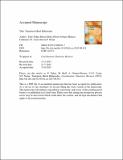Transition metal bifluorides
Date
15/01/2016Metadata
Show full item recordAbstract
Since its initial discovery, four decades ago, transition metal bifluoride chemistry has exhibited a slow growth, mainly due to problems associated with synthesis and characterization. Until recently, reports on this chemistry almost always presented these complexes as a fluke discovery. However, with the recent increase in reports and applications involving such species, a renewed interest in these complexes has been observed. Most of the work done in this area, so far, has been directed toward the synthesis and quite challenging characterization of these complexes, yet mostly neglecting the behavior of such species and their influence on catalytic processes. The aim of this work is to present a summary of the various preparation methods, characterization techniques and applications of reported transition metal bifluoride complexes. It is our hope that by centralizing all information available on such species, future efforts aimed at exploiting the full potential of transition metal bifluoride species can be facilitated.
Citation
Nahra , F , Brill , M , Gomez Herrera , A , Cazin , C S J & Nolan , S P 2016 , ' Transition metal bifluorides ' , Coordination Chemistry Reviews , vol. 307 , no. Part 1 , pp. 65-80 . https://doi.org/10.1016/j.ccr.2015.08.011
Publication
Coordination Chemistry Reviews
Status
Peer reviewed
ISSN
0010-8545Type
Journal article
Description
CSJC acknowledges the Royal Society for a University Research Fellowship and the EaStChem School of Chemistry for support. SPN acknowledges the EPSRC and is a Royal Society Wolfson Merit Award holder. AGH thanks the EPSRC (EP/K503162/1) and Syngenta for support.Collections
Items in the St Andrews Research Repository are protected by copyright, with all rights reserved, unless otherwise indicated.

